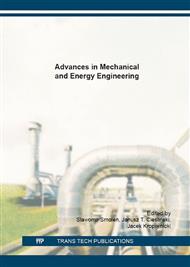[1]
Prabhanjan D. G., Raghavan G. S. V., Rennie T. J.: Comparison of heat transfer rates between a straight tube heat exchanger and a helically coiled heat exchanger. Int. Comm. Heat Mass Transfer, Vol. 29, No 2, 185-191, (2002).
DOI: 10.1016/s0735-1933(02)00309-3
Google Scholar
[2]
Zachár A.: Analysis of coiled-tube heat exchangers to improve heat transfer rate with spirally corrugated wall. International Journal of Heat and Mass Transfer, Vol. 53, 3928-3939, (2010).
DOI: 10.1016/j.ijheatmasstransfer.2010.05.011
Google Scholar
[3]
Genić S. B., Jaćimović B. M., Jarić M. S. Budimir N. J., Dobrnjac M. M. : Research on the shell-side thermal performances of heat exchangers with helical tube coils. International Journal of Heat and Mass Transfer, Vol. 55, 4295-4300, (2012).
DOI: 10.1016/j.ijheatmasstransfer.2012.03.074
Google Scholar
[4]
Logie W.: Immersed Coil Heat Exchangers. Solartechnik Prüfung Forschung, October 22, 1-11, (2007).
Google Scholar
[5]
Ali M. E. : Laminar natural convection from constant heat flux helcal coiled tubes. International Journal of Heat and Mass Transfer, Vol. 41, No. 14, 2175-2182, (1998).
DOI: 10.1016/s0017-9310(97)00322-0
Google Scholar
[6]
Prabhanjan D. G., Rennie T. J., G., Raghavan G. S. V.: Natural convection heat transfer from helical coiled tubes. International Journal of Thermal Sciences, Vol. 43, 359-365, (2004).
DOI: 10.1016/j.ijthermalsci.2003.08.005
Google Scholar
[7]
Ali M. E.: Free convection heat transfer from the outer surface of vertically oriented helical coils in glycerol-water solution. Heat and Mass Transfer, Vol. 40, 615-620, (2004).
DOI: 10.1007/s00231-003-0431-2
Google Scholar
[8]
Ali M. E.: Natural convection heat transfer from vertical helical coils in oil. Heat Transfer Engineering, Vol. 27, No. 3, 79-85, (2006).
DOI: 10.1080/01457630500458617
Google Scholar
[9]
Ali S.: Pressure drop correlations for flow through regular helical coil tubes. Fluid Dynamics Research, Vol. 28, 295-310, (2001).
DOI: 10.1016/s0169-5983(00)00034-4
Google Scholar
[10]
Wiśniewski S., Wiśniewski T. S. : Wymiana ciepła. Wydawnictwa Naukowo-Techniczne, Warszawa (1994).
Google Scholar
[11]
Niezgoda-Żelasko B., Zalewski W. : Chłodnicze i klimatyzacyjne wymienniki ciepła. Wydawnictwo Politechniki Krakowskiej, Kraków (2013).
Google Scholar
[12]
Berkel H., Mitra N. K., Fiebig M. : Experimentelle Untersuchung des Wärmeüberganges durch freie Konvektion an waagerechten Rippenrohren in einem zylindrischen Behälter. Wärme und Stoffübertragung, Vol. 18, 167-173, (1984).
DOI: 10.1007/bf01466348
Google Scholar
[13]
Staniszewski B. : Wymiana ciepła. Podstawy teoretyczne. Państwowe Wydawnictwo Naukowe. Warszawa (1979).
Google Scholar
[14]
Haaland S. E. : Simple and Explicit formulas for the friction factor in turbulent pipe flow. Journal of Fluids Engineering, Vol. 105, 89-90, (1983).
DOI: 10.1115/1.3240948
Google Scholar
[15]
Wetly J. R., Wicks C. E., Wilson R. E., Rorrer G. L. : Fundamentals of momentum, heat and mass transfer. Wiley, (2008).
Google Scholar


